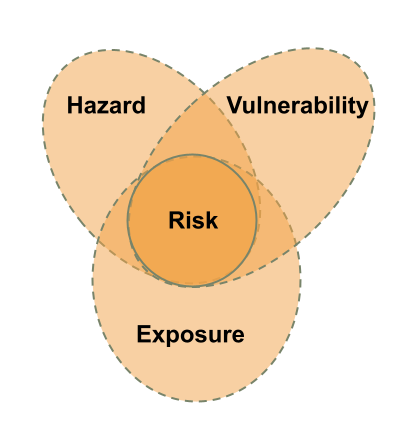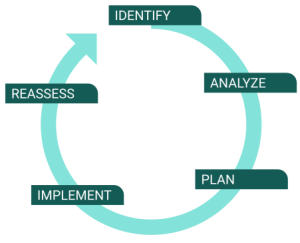3 Risk Analysis and Assessment
Risk: The math and meaning
Risk is a forward-looking concept, as opposed to a present situation or a past event. It aims to assess the final result of combining the following measurable items: hazard, exposure and vulnerability.
Disaster risk can be understood as the likelihood (or probability) of loss of life, injury or destruction and damage from a disaster in a given period of time. Or, more clearly: disaster risk is the consequence of the interaction between a hazard and the characteristics that make people and places vulnerable and exposed.


The meaning of the three risk components:
- Hazard: a dangerous event that may cause loss of life, injury or other health impacts, as well as damage and loss to property, infrastructure, livelihoods and services, social and economic disruption and, or environmental damage; as a component of risk, it is the probability of experiencing a certain intensity of hazard (eg. earthquake, cyclone, etc.) at a specific location and is usually determined by a historical or user-defined scenario, probabilistic hazard assessment, or other methods. Some hazard modules can include secondary perils (such as soil liquefaction or fires caused by earthquakes, or storm surge associated with a cyclone).
- Exposure: the presence and number of people, property, livelihoods, systems or other elements in hazard areas (and so thereby subject to potential losses); as a component of risk, it represents the stock of property and infrastructure exposed to a hazard, and it can include socioeconomic factors.
- Vulnerability: the set of characteristics and circumstances of a community, system or asset that make it susceptible to the damaging effects of a hazard. As a component of risk, it accounts for the susceptibility to damage of the assets exposed to the forces generated by the hazard. Fragility and vulnerability functions estimate the damage ratio and consequent loss respectively, and/or the social cost (e.g., number of injured, homeless, and killed) generated by a hazard, according to a specified exposure.
Resilience is related to vulnerability. Resilience is the ability of a person or group to return to normal after a loss or shock. A vulnerable person probably is not very resilient. There are many ways to obtain data on the different components of risk. The following video shows how human behavior patterns for credit card usage changes in preparation for a known disaster, during the disaster and in the recovery stage.
Risk, Real Risk, Perceived Risk, Tolerance
This section is based on a section from Outward Bound. It has been modified from a focus on outdoor recreation to apply to a broader range of natural hazards and risk.
Defining Risk
Risk refers to the potential of encountering harm, danger, or adverse events. The level of risk
can vary depending on factors like the type of activity, environmental conditions, participant experience, and safety measures in place.
Understanding and managing risk involves recognizing potential hazards, assessing the likelihood and severity of negative outcomes, and implementing strategies to minimize or mitigate those risks. This may include proper planning, situational awareness, understanding and managing human factors, technical and relational skill development, use of safety equipment, adherence to guidelines, and awareness of changing conditions.
Real Risk
Real Risk represents the actual potential for loss from existing surrounding hazards and perils or the amount of risk that exists at a given moment in time. It is the objective potential for loss from hazards and perils.
There is a real risk of earthquakes throughout most of Alaska. The physical processes are known to be present there. We have data on loss of lives and finances in the region.
Perceived Risk
Perceived risk is the individual’s subjective assessment or belief regarding the level of danger associated with a specific activity or location, which may or may not align with the actual level of risk.
As an example, some individuals may perceive an activity as risky even if the objective risk is relatively low.
Risk perception can significantly influence decision-making and behavior. Even when the actual risk is low, if an individual perceives it as high, they may avoid the activity or take extra precautions. Those extra precaution may cost time and money which could be more effectively spent reducing real risk. The impact of perceived risk extends to policies and perhaps inefficient distribution of resources for planners and officials. Below, we discuss factors such as risk tolerance, activity selection, perceived level of challenge, and the educational value of risk.
Risk Tolerance
Risk tolerance is defined as “the level of risk an entity is willing to assume in order to achieve a potential desired result.”
Leaders and officials must consider the perceived risk tolerance levels of the population they are working with. Organizations (political or not) and individuals must carefully consider the balance between risk and reward when planning and implementing activities.
Everyone has a different level of natural risk tolerance. Some may be more risk-averse, while others accept more risk, at least in some situations.
If you are working to protect a community, you must work to understand their risk tolerance, whether it is real or perceived risk.
Personal risk tolerance can be shaped by many factors, including experience and training (which often, but not always increases risk tolerance), personality, gender, cultural factors, etc. To mitigate these differences it is important to be guided by established goals and organizational risk tolerance. At the global scale these goals are are clarified by the Sendai Framework, among other guiding documents.
A Risk (or Probability) Matrix
In risk analysis and assessment we are trying to answer three broad questions:
1. What could go wrong? This course focuses on a series of natural hazards: quakes, floods, etc.
2. What is the likelihood that it will go wrong? The likelihood is determined by spatial and temporal variables. We need to know where the physical processes happen and how frequently they happen there.
3. What are the consequences of it going wrong? We assess losses that were incurred for a similar event at the same location in the past and compare with similar events in other locations.
To help visual how multiple variables (the likelihood and the consequences) interact, a probability matrix can be created. Here is a simple probability matrix. It compares three levels of severity and three levels of likelihood. If you have more data to justify it, you can add more classes of severity and likelihood. In general, one axis shows increasing severity and consequences while the other axis shows increasing likelihood of occurrence. In the yellow cells are events that are rare and low impact. In the red are events that are more common or greater impact or both. The likelihood is often determined with data obtained over a period of time. It’s a frequency. The severity classes could be either qualitative (people vote) or quantitative (based on past incidents, what were the losses incurred when an event happened).
The probability matrix serves as a simplified model and an effective decision-making tool. Its purpose is to guide us in determining whether to proceed with an activity, exercise caution, or implement additional mitigation strategies. This tool encourages thoughtful consideration of the potential undesired consequences associated with a chosen course of action. By applying the Probability Matrix, individuals can make more informed decisions, taking into account various factors that may impact the safety and success of the activity.
| Least Severe (1) (negligible?) |
Moderately Severe (2) | Highly Severe (3) (catastrophic?) |
|
| Least Likely (1) Rare | 1 | 2 | 3 |
| Moderately Likely (2) | 2 | 4 | 6 |
| Most Likely (3) Almost certain to happen | 3 | 6 | 9 |
High Probability/Low Consequence
In these instances, the Probability Matrix indicates a high likelihood of a mishap, but the consequence is low.
Location may have a significant impact on activities here. In remote areas far from help, some activities may shift from low severity and minimal impact to life threatening. Breaking a leg as you slip and fall just outside the hospital is much different than breaking your like while hiking alone and three days into the wilderness.
High Probability/High Consequence
Here, the likelihood of an incident occurring during the activity is high, and if such an incident were to happen, the consequences would also be high. An example is standing in an open field during an active thunderstorm (risk of lightning strike). There is a high probability of being struck by lightning and having a deadly outcome.
Low Probability/Low Consequence
Here, the likelihood of an incident occurring is low or improbable, and if something does happen, the consequences are of little consequence. Examples include handling paper with bare hands (risk of a paper cut) or walking in the open wearing sunscreen in good weather (minor sun exposure).
While this quadrant might be considered ‘safe’, there is a potential drawback to consistently favoring activities in this category. Remaining exclusively in this low-consequence, low-likelihood quadrant might hinder growth and discovery. That’s not exactly the mentality of “to boldly go where no man has gone before”.
While certain activities may fall into the Low Probability-Low Consequence category, again it’s crucial to recognize that even minor consequences can escalate into serious or life-threatening situations in areas with greater vulnerability and less accessibility.
Low Probability/High Consequence
Here, the likelihood that an incident will happen is quite low or improbable; however, if something does occur, the consequences could be drastic and tragic. One example falling into this category is tsunamis and many other natural hazards.
These incidents occur rarely, however, when they do happen the outcome can be severe or catastrophic.
How are events assigned within a risk matrix?
We are using the concepts of risk and hazard for cases of natural hazards and disasters, but similar concepts are routinely applied to economic risk analysis and insurance or to industrial safety programs. You do some amount of risk analysis every day. Should you jaywalk to the other side of the street? Should you invest in Tesla stock?
In a manufacturing situation, probably an outside consultant who specializes in risk reduction would do an analysis of the site. As an outsider and a general expert on risk, they might see issues that local employees take as normal. That same consultant will speak with employees about real, experienced hazards and losses (injuries), and to administrators (finances).
For natural hazards, it’s quite similar. Residents of a region may have concerns (perceived risk) and losses (real risk) and specialists might have more data and experience with certain natural hazards. These combine qualitative (I think… I feel… I’m concerned) and quantitative ($10M in damages last year) data to create a risk matrix. That matrix, created with the public input and specialists, helps guide plans to reduce risk.
Where would you place these events on a risk matrix?
- Your home flooding within 10 years
- Your home burning in a wildfire in 10 years
- You earn a below-average grade on a Violent Earth exam
- Your dog eats your chocolate bar
- Your dog eats your mom’s chocolate bar!
What to do with this
Risk management is a cycle of identifying risk, implementing changes to reduce risk, evaluating the affect of the changes, and making further changes.

After, and during, risk assessment, we are trying to determine a best course of action. We use the process to help us decide if:
An given activity should be allowed? (Should home be built in the 200 year floodplain?)
Are additional precautions and improvements needed? (Is a levee needed?)
Which options are preferred? (no levee, medium height, or tall levee)
How much should be invested to reduce the risk? (who, how many, what, how much is being saved at what price?)

